June 18, 2004
Air Date: June 18, 2004
FULL SHOW
SEGMENTS
Fungal Facts
View the page for this story
The problems of mold range from nuisance to nightmare, and seemingly harmless fuzz can ripen to full-blown infestation in the wrong conditions. Husband and wife Jeffrey and Connie May know mold intimately. They run a mold investigating business in Cambridge, Massachusetts. The Mays tell Living on Earth host Steve Curwood about some of the challenging and, sometimes, heartbreaking cases they’ve been called in to clean up, and how the average homeowner can guard against even the most persistent spores. (12:47)
Your Chemical Body Burden
/ Ingrid LobetView the page for this story
More and more people are demanding the right to know what chemicals are in their bodies. In California, a bill is being pushed that would set up the first statewide biomonitoring system to collect and analyze breast milk. But some fear testing might cause people to confuse chemical exposure with illness and cause undue alarm. Living on Earth's Ingrid Lobet reports. (15:30)
Emerging Science Note/Low-Carb Spuds
/ Jennifer ChuView the page for this story
Living on Earth’s Jennifer Chu reports on a new low-carb potato that could whet the appetite of even the most diligent Atkins dieter. (01:20)
Plight of the Moon Bear
View the page for this story
Since the 1980s, the practice of bear farming has devastated populations of Asiatic black bears, more commonly known as moon bears. These bears are hunted for their bile which has been proven to be medically beneficial to humans. Host Steve Curwood talks with Jill Robinson, founder of the China Bear Rescue Project, about the conditions that she’s witnessed on bear farms throughout Asia, and her attempt to reverse the long-held belief that bear farming will save the moon bear. (15:30)
This week's EarthEar selection
listen /
download
Show Credits and Funders
Show Transcript
HOST: Steve CurwoodGUESTS: Connie May, Jeffrey May, Jill RobinsonREPORTER: Ingrid LobetSCIENCE NOTE: Jennifer Chu
[THEME MUSIC]
CURWOOD: From NPR, this is Living on Earth.
[THEME UP AND UNDER]
CURWOOD: I’m Steve Curwood. Practitioners of traditional Chinese medicine put a high price on the healing power of bear bile, and for centuries thousands of bears were slaughtered for their organs. Few bears are being killed for their gall bladders these days. Instead, many now suffer a fate perhaps worse than death. On bear farms throughout Asia the animals are being help captive, immobilized in small cages, while they are milked of their bile.
ROBINSON: They had head wounds from where they’d consistently banged their heads against the bars of the cage, they had gaping infected holes in the middle of their abdomens. I mean, I don’t know how anyone listening to this can comprehend the suffering that a sentient species, an animal that feels pain in the same way that we do, can actually tolerate this existence for up to 20 years of its life, which is what these bears do.
CURWOOD: The plight of the Moonbears of Asia, and more, this week on Living on Earth. Stick around.
[NPR NEWSCAST]
ANNOUNCER: Support for Living on Earth comes from the National Science Foundation and Stonyfield Farm.
Fungal Facts
CURWOOD: From the Jennifer and Ted Stanley Studios in Somerville, Massachusetts, this is Living on Earth. I’m Steve Curwood.
We begin our program this week with an examination of … mold. Okay, granted, not the world’s most pressing problem these days, but if mold gets trapped in your carpets, or festers between walls, it can make you sick to the point you may have to evacuate your home. Chronic problems with mold spores have spurred an industry of cleanup crews and special investigators who sniff out the source of stubborn mold growth and get rid of it.
Joining me now are husband and wife Jeffrey and Connie May. They run a mold detective agency in Cambridge, Massachusetts, and field all sorts of calls for fungal emergencies. They’ve written a book on the science and sources of mold, and how you can rid your home of even the most persistent spores. It’s called “The Mold Survival Guide: For your Home and for your Health.”
Jeffrey and Connie May, welcome to Living on Earth.
C. MAY: Thank you. Thank you for having us, Steve.
J. MAY: Thank you, Steve.
CURWOOD: So, what exactly is mold? I understand that there are a lot of varieties but, principally, what do we come in contact with in our homes?
J. MAY: Well, mostly we come in contact with the spores, which are sort of the reproductive seeds of mold. But mold is a plant-like growth, and wherever it’s warm and damp the spores will germinate and start to grow. Most people are familiar with the colonies – they see little round dots, maybe it’ll be on the bathroom ceiling, or it’ll be on the outside of the house.
Most of the molds are either black or brown or sort of greenish or bluish colored. But some are white. And, you know, a lot of people say mold is everywhere. And I think that’s a shame, it’s a real misconception, because although spores are everywhere in the air – because they’re dispersed by the wind – mold is not everywhere. And it’s very unhealthy to live in a house where there’s mold anywhere, or to be in a building. You should not have mold -- visible mold -- on the ceiling tiles, you shouldn’t have visible mold on walls, because the mold produces billions – one colony like that, that you can see, produces millions to billions of spores.
CURWOOD: So, what happens to somebody if, in fact, the mold is in their house?
J. MAY: Well it really depends. Some people get asthma, some people develop chronic coughs, other people have asthma symptoms. But just the fact that you see mold on a surface doesn’t necessarily mean that you’re breathing it. And, in some situations, I’ve actually test-sampled the air where there was a lot of mold – say on a wall or a ceiling – and not found any mold spores at all.
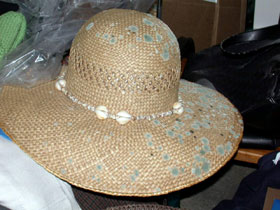 This straw hat was in a home where the furnace humidifier malfunctioned while the family was away on a winter vacation. (Photo: Jeffrey May)
This straw hat was in a home where the furnace humidifier malfunctioned while the family was away on a winter vacation. (Photo: Jeffrey May)
C. MAY: Yeah, people call us up and they’re worried about the mold they see in their attic, or they’re worried about the mold they see on their bathroom ceiling. But it’s really the mold that they don’t see in their basement carpets, or in the fiberglass insulation, that’s going to be contaminating the air they breathe.
CURWOOD: Connie, in your work in helping people figure out how to straighten their homes out from mold, what are they key things that you look for? Where do people typically get into trouble with mold at home?
C. MAY: Well, moisture control is, I think, of paramount importance. And when people think about moisture control they think about leaks and visible water that intrudes into their home one way or another. And really, it’s relative humidity that’s the biggest problem in homes.
CURWOOD: Relative humidity? This is uncle, or your aunt?
C. MAY: (LAUGHS) No, relative humidity is a measure of how much moisture the air holds in relationship to how much it can hold at any given temperature. So, if air at a certain temperature is 70 percent relative humidity, it means it can hold 30 percent more before it’s saturated. And many kinds of molds can flourish in 70 percent relative humidity, in the absence of liquid water. And people don’t understand this so they allow conditions to arise in their homes that are conducive to mold growth. And then they worry about the leak behind the bathroom wall whereas, really, it’s the basement carpet that’s the problem.
J. MAY: The reason why we’re not all having mildew everywhere is because you need consistent periods of relative humidity in order for the growth. So, if the relative humidity, let’s say in the bathroom, goes up to 85 or 90 percent for 15 or 20 minutes, you open the door and then it drops down again. So, time is really important as well as the, you know, the relative humidity.
CURWOOD: Okay, somebody’s got a mold problem. What’s the sure-fire way to get rid of it? In your book you say that bleaching isn’t enough.
J. MAY: It’s pretty complicated so it’s not something you could really just, you know, give somebody advice. I made that mistake once. I was talking about maybe using a little bleach on an air conditioner. And then I suddenly realized, you know, if you’re on the fourth floor of an apartment house and you pour a quart of bleach into your air conditioner, somebody down on the street is going to be walking along. They’ll probably end up blind or you’ll bleach their red shirt or something.
So I think cleaning advice – it’s complicated. But a good example, I’d say, would be in a bathroom. People have been cleaning mildew out of their bathrooms for years and that’s certainly a perfectly doable task. On the other hand, if you got a basement full of mold then you may have to get some professionals to do that, and you have to be very careful, particularly if people who are sensitized or involved in the cleanup.
But the big mistake that anybody can make is to clean up a big mold problem and then not really change the conditions that led to the growth. You can clean things up – and we get calls like this all the time from people, you know: “We bleached the bathroom again and there’s mildew everywhere, and what’s wrong? Why do we have to keep doing this?”
C. MAY: Or, “we spent $5,000 and had professionals clean our basement and now there’s mold again.” And meanwhile, they’ve got cardboard boxes directly on the concrete slab and they’re not dehumidifying the basement so mold comes back. It’s not like lead paint – it’s not either there or not there. It’s a living thing so it will re-occur.
CURWOOD: You write in your book that “mold is gold.” That, well, the business of mold removal, dare I say, has mushroomed along with the awareness? [LAUGHTER] Can you talk about this, and tell me what you’ve come across along these lines personally?
C. MAY: Well, I think that mold is certainly a concern and something to take very seriously but I also think that because they’re so worried about it, people have been sort of duped. And we’ve had people who’ve called up with a soot problem in their home and they think it’s mold or they have efflorescence in their basement and they’ve been told they need a $10,000 cleanup job and they move into a hotel. And it’s not mold. So, I think understanding it will help people reach clarity about when to worry, when not, what is and what isn’t mold.
J. MAY: You know, the mold is gold…they have special courses for attorneys on how to litigate mold problems, they’re traveling around the country. There’s courses for mold inspectors on how to sample for mold and there are labs that are sprouting up everywhere and a lot of them really aren’t all that competent. So it’s a wild west sort of frontier out there.
CURWOOD: Jeff, you say in your book up front that you have mold allergies and yet you work with it everyday. Why do you do this to yourself?
J. MAY: Well, it’s a little crazy but, actually, we try and help people and I use my own sensitivity really to help find problems. But I do also have some pretty sophisticated instrumentation that I use. So, what it does, the way it helps me is that it directs me to the place where there are problems. If people who are not sensitized go into a space, they don’t know where to start but I know where to start.
CURWOOD: So, what’s it like to live with somebody who is highly allergic to mold and yet dives into it everyday?
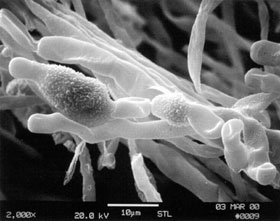 Cladosporium spores are often the most abundant type of spores, found in air both indoors and outdoors. (Photo: Jeffrey May)
Cladosporium spores are often the most abundant type of spores, found in air both indoors and outdoors. (Photo: Jeffrey May)
J. MAY: 16,000 samples.
C. MAY: Sixteen thousand samples that he’s taken. So, what’s it like? I’ve gotten used to being married to someone who’s brilliantly obsessive
CURWOOD: What if some of this mold escapes into your house?
C. MAY: You’ve been doing it for fourteen years and nothing’s ever escaped.
J. MAY: Actually once I did. I dropped one Petri dish that was full of mold and I was so fearful but the first thing that I did was I slammed the door shut and then I got an air sampler out because I wanted to see how bad it really was. And it was this penicillium mold and the entire room was full of spores. And then I put an exhaust fan in the window for five minutes and I took a sample again and it was all gone. So it was important to me to know that in minutes you could get rid of a problem like that.
CURWOOD: Connie, how do you see mold and fungi?
C. MAY: Well I used to think it was disgusting [LAUGHS]. But now that I’ve watched Jeff become so interested and I’ve learned so much about it I think it’s very interesting but for me, also, it’s a human story because I’m the person whose on the frontlines in terms of talking with people when they first contact the business. And so, I’m the first person who hears these terrible stories and speaks with usually women, often women, and usually when there’s another woman on the phone when they call they often are crying, they’re often dealing with children who are very, very sick. And so, for me, mold is, of course, part of science and nature but it’s also a human drama and that to me is both interesting and kind of tragic.
CURWOOD: Tell me one of the most compelling stories you’ve heard.
C. MAY: Well, I think one of the most compelling stories I heard was the family with the little girl, she was four, was she, Jeff? On the couch, remember she was?
J. MAY: Oh, right. Younger even.
C. MAY: She was three, she was taller. And her asthma was so bad that her parents took turns sleeping in her room every night on a mattress on the floor so that they could give her her medication with a nebulizer. And they’d done everything they could possibly think of to clear the house of allergens: they’d removed all the wall to wall carpeting, they’d gotten rid of all the curtains, they put extra filtration in the system, they’d gotten a vacuum. A whole long list of things that they’d done and still she was getting very, very sick. And Jeff went over to the house to do testing and found that the furniture was contaminated and the parents had said “well she doesn’t go into that room,” but they didn’t realize that every time someone sat on the furniture allergens became airborne and went with airflows to where she was. So within two weeks, she was off her nebulizer and they had a normal life with her. So I found that very moving.
CURWOOD: Now, I’m looking at your book here, Jeff, and along with your experiences and instructions you have some pretty vivid pictures of mold. Here is, looks like a fungus growing out the side of a house?
|
|
CURWOOD: I have to ask you…these are pretty vivid pictures and I can’t help but think that you find these pictures kind of fascinating. J. MAY: Absolutely. It’s part of nature; it’s an extraordinary beautiful thing when you look at these things under a microscope, it’s incredible. And you see how all the different living things interact with each other, you know, the mold, the bacteria, the insects that eat them. I can’t take my eyes off them. I guess it’s just another world. C. MAY: It’s nature’s recycling. J. MAY: Yep. CURWOOD: Jeffrey and Connie May are authors of called “The Mold Survival Guide: For your Home and for your Health.” Thanks so much for taking this time with me today. J. MAY: Thank you, Steve. C. MAY: Thank you. CURWOOD: Coming up -- the growing trend to help people find out just how many toxic chemicals have built up in their bodies over the years. Biomonitoring is next. Stay tuned to NPR’s Living on Earth. [MUSIC: “City of Pleasures” GOVINDA (Earthtone) 2002] Related link:
Your Chemical Body BurdenCURWOOD: Welcome back to Living on Earth, I’m Steve Curwood. In many cities and towns across the U.S. you can read the local newspaper to find out what’s in the air you breathe. And in many communities, the water company will tell you what’s flowing from your tap. It’s useful information but, these days, some people are demanding more. They want to find out what synthetic chemicals are in their blood, urine and breast milk. Scientists at the National Centers for Disease Control have started keeping data on what substances are found in the tissues of the average American. But some people say averages aren’t enough -- that there’s an individual right to know, as well. In California, groups are pushing a bill that would set up the first statewide collection and analysis of human fluids. Living on Earth’s Ingrid Lobet reports on the growing trend in biomonitoring. LOBET: As Sharyle Patton sat in a tiny clinic room watching her blood fill yet another vial, she mused that after years as an activist lobbying against persistent chemicals, she would finally learn her own chemical fingerprint -- what had built up in her body over a lifetime. When the results were emailed to her, she compared notes with several friends. PATTON: Well, we all had funny different reactions to it. Some of us looked at our scores and felt good because our numbers were less than other people in the group [laughs]. I mean, there was that kind of reaction. And I looked at my PCB levels and realized they were really high. And I thought, my goodness, I’ve just about won the PCB contest. And that my dioxin levels are as high as some folks that live in Louisiana, in Cancer Alley. LOBET: The levels were a surprise for Patton because she’s chosen to live amid the wild green of Bolinas, a famously remote community on the coast north of San Francisco. PATTON: I grew up in Colorado, in a high mountain town, far away from factories and industry and incinerators, right, growing our own cattle, our own vegetables. So, the fact that I had these high levels said a couple of things. First of all, it’s really hard to figure out the pathway of exposure by looking at your body burden levels. You just really don’t know. You can’t tell. There’s no little marker on that chemical that says it was manufactured by this company, or this is where you got it. There’s no way I can send a bill to anyone for using my body as a toxic waste site. LOBET: Patton’s body, it turned out, contained 105 of the 210 metals and synthetic chemicals researchers tested for. Safe levels for many haven’t been set. Her test results are consistent with other studies in the United States and Europe that chart the intrusion of the Industrial Age on the human body. Certain pesticides, for example, and PCBs used in plastics and insulators, find their way into living things and settle in fat. Some are passed to babies in utero. Interest in body burden testing, or “biomonitoring”, has spiked since the late 1990s when scientists discovered that a type of chemical flame retardants – called PBDEs – had rapidly been building up in animals and humans. As reported previously on Living on Earth, those flame retardants – used in foam mattresses, drapes and furniture – have now been found just about everywhere researchers have looked for them: in whales, in seabird eggs, in seals, and in breast milk, and nowhere higher than the United States. Speaking last year on this program, California State Toxicologist Tom McDonald explained why these fire suppressants are a concern for developing babies. MCDONALD: There's three primary concerns that we have with respect to health effects, and those include neuro-developmental changes, meaning learning and memory deficits in children, also thyroid hormone disruption, as well as possibly cancer. The concern basically comes from animal studies that have all shown that either in rats and mice, when you give PBDEs to them, either in utero or early after birth, you get permanent changes in behavior and learning and memory. HOOPER: [Giving tour of lab] These are two half -million dollar machines, high resolution mass spectrometer and gas chromatography. LOBET: At the same lab where researchers found the flame retardants in seals and American breast milk, another researcher is taking the issue one step further. Environmental biochemist Kim Hooper is asking a question you don’t often hear from American scientists – whether the current way of regulating chemicals is sufficiently protective of fetal and infant health. HOOPER: For the last 25 years we’ve been following this paradigm of we need to show a chemical disease-human disease connection. And it hasn’t worked because we’re not really regulating that many more chemicals than we were 25 years ago. So, we need some kind of new paradigm -- and one new paradigm would be, let’s look at body burdens, chemical body burdens. LOBET: After activists learned of the research on PBDEs, they helped get two widely used retardants banned in California. The manufacturer then volunteered to stop making them, but the activists want more. Donne Brownsey is a lobbyist in Sacramento for the Breast Cancer Fund. She hopes a broad program for body burden testing might one day reveal why one in eight women in the United States develops breast cancer. BROWNSEY: We believe breast cancer is a public health crisis. We believe we can no longer just ask women to be dutiful about doing monthly exams. We have to start looking at environmental causation. LOBET: And Brownsey believes the increased interest in biomonitoring indicates a shift in public attitude. BROWNSEY: We think that, finally, some of these environmental issues have rightfully taken their place as environmental health issues. [SOUND OF VOICES, DISCUSSION IN A SACRAMENTO OFFICE] LOBET: The emerging movement in America to test human beings for chemicals has found its center in the office of California State Senator Deborah Ortiz. She’s authored a bill that would create the first statewide human monitoring program in the country. ORTIZ: There are other countries that have actually done this – Sweden, Germany, as well – that have been doing this over time, and measuring body burdens. So someone suggests that we’re really behind the curve in California. LOBET: If her bill becomes law, scientists would choose three distinct communities for initial testing. Senator Ortiz, who chairs the Senate Health Committee, sees biomonitoring as a powerful political tool because it could reveal geographic differences in exposure. ORTIZ: So that we can, in fact, measure women who live in East Los Angeles who live near an incinerator, or women who live in an area in the Central Valley where there is a lot arsenic in the water, as well as women who live in relatively non-heavily populated, non-industrial areas. I’d like to get us to the point where we have so much information that we can’t turn a blind eye, that we can’t turn our back to the huge, huge problems and the risks that we are placing on women throughout California. And maybe that data will get us there. LOBET: Ortiz’s emphasis on women points to one sensitive aspect of the California bill: it intends to find out what’s in people’s bodies by testing breast milk. Breast milk contains more fat and so more of the fat-loving chemicals than blood. And you don’t need a needle to extract it. But advocates of the bill, like Donne Brownsey, say there’s a political reason for choosing breast milk, too. BROWNSEY: We believe that if breast milk talks, people will listen. [SMACKING SOUNDS OF SUCKLING BABY] LOBET: Little Nicholas Howard clamps his mouth onto his mother’s breast. But then he notices a microphone intruding on his nursing nirvana. And there’s another distraction: his buddy Antonio. [BABY-TALK SOUNDS BETWEEN THE TWO BOYS] LOBET: Some worry that using breast milk as the test fluid might dissuade some women from breastfeeding. I ran that concern past nursing moms Jane Donofrio and Carolyn Howard. DONOFRIO: I would give a sample immediately. I don’t know, what do you think? HOWARD: I would be interested in giving a sample, first of all, just to see what was in my actual breast milk because that would give me more information. So I wouldn’t have reservations about going ahead and giving a sample. DONOFRIO: Absolutely. I mean that’s why I think we eat the way we eat. When you know you’re giving it to your baby, it’s like, okay, I’ll get the organic peppers -- even if they’re more expensive ‘cause it’s worth it. And breast milk, like in relation to formula, I think, okay, there’s negative things in it, but maybe that’s where we can address our society on a whole with toxins in our world. You know, it’s more of a societal huge issue as to we have these things in our bodies, and why certain things are contaminated. [CUTE SOUNDS FROM THE BABIES, BABY-TALK, LAUGHING] LOBET: Few people have contemplated both the contamination and the health benefits of breast milk as much as biologist Sandra Steingraber of Ithaca College. Steingraber has been calling for a national dialogue on contaminants in breast milk. I asked her to read from a letter she wrote for the Ribbon newsletter from Cornell University. STEINGRABER: “Breastfed infants have fewer respiratory infections, diarrhea, middle-ear infections, and die less often from Sudden Infant Death Syndrome. Breastfed infants grow into children who suffer less than their bottle-fed counterparts from juvenile diabetes, rheumatoid arthritis, obesity, dental malocclusions, and some leukemias. They respond more vigorously to vaccinations. They have better hearing and visual acuity. They develop balance and gross motor coordination more quickly.” “It's also true that breast milk commonly violates Food and Drug Administration action levels for poisonous substances in food. Were it regulated like infant formula, the breast milk of many U.S. mothers would not be able to legally sold on supermarket shelves.” LOBET: Steingraber is very careful to send a pro-breastfeeding message. She always made sure she was photographed breast-feeding her baby, Elijah. STEINGRABER: The people who are advocating it in the public health community, the lactation community, the midwifery community, pediatricians and obstetricians -- they’re very touchy about any negative comment about breastfeeding and breast milk. And I feel that way myself. On the other hand, I don’t think public health is ever served by keeping secrets, and the idea that nursing women should be protected against knowledge about what’s in their milk to me is profoundly condescending. Certainly, as a nursing mother myself, I certainly want to know what’s in my milk – in the same way I want to know about infant car seat recalls. LOBET: But while advocates of biomonitoring see it as a right-to-know issue, others see California’s efforts as lacking focus and even irresponsible. The American Chemistry Council in a letter says that it’s wrong to test breast milk and then somehow see the results as an indicator of community health. The council, which represents chemical manufacturers and users, says people mustn’t confuse chemical exposure with harm. And some scientists share that concern. [MACHINE SOUNDS FROM CHEMICAL LAB] KRIEGER: To many people, knowing that they’re exposed spells disease. Exposure isn’t a disease. Exposure is contact and absorption of a chemical. LOBET: At the University of California at Riverside, toxicologist Robert Krieger and his associates analyze pesticides in human urine. Krieger supports the federal biomonitoring studies carried out by the Centers for Disease Control. But he believes the kind of biomonitoring where individuals get their own results back could cause unnecessary alarm. KRIEGER: It’s possible to measure much, much less than the amounts that have any biological significance in terms of health. And given the poor general information that people have about chemicals and their bodies, I would think that a program such as that might carry more liabilities than benefits. DINOFF [IN THE HUM OF THE LAB]: If I can give you an example here of a compound that I found while doing an analysis… LOBET: Researcher Travis Dinoff points to a screen showing a wave form of one chemical in a urine sample from a farm worker. DINOFF: This turns out to be oxybenzone which is a sunscreen. And if someone got a result back that said they had been exposed to oxybenzone, they might say, “oh God, I’ve been exposed to this chemical.” But it’s actually something that they put on their skin on purpose, and those compounds are going to be absorbed and excreted somehow out of the body. LOBET: Professor Krieger is suspicious that many people who want widespread biomonitoring really just want a back door to more chemical regulation. KRIEGER: The numbers game is very treacherous. The normal strategy is to find the low level of something, and associate risk with it. And then regulate that material at extremely low levels as though you are removing a risk. If the risk was nil or zero when you started, no matter how much you reduce it, you haven’t done anything. The public has not gained anything. LOBET: Kreiger’s concerned the side effects of that could be wasted money and an unwarranted fear of chemicals. To see if other researchers share this worry, I turned to Dana Barr who has worked on the biomonitoring program at the Centers for Disease Control and heads the pesticide lab there. I asked her if she has reservations about testing as a tool in the hands of individuals. BARR: I do. Because when you get all these data, a lot of them aren’t that easy to interpret right now on an individual basis. There are some that do have a clinical outcome associated with them – for instance, lead or mercury exposure – and so getting tested for those would make real sense because then you could reduce the exposure; there’s some sort of intervention that could occur. If you get tested for many of these other chemicals, we really don’t know if there are health outcomes associated with it. So, the data are largely uninterpretable on an individual level. LOBET: But Dana Barr says she welcomes testing in city and state-run programs, like ones being planned for New York City, New England, the Rocky Mountain west, and California. BARR: Oh, I think it’s an outstanding idea. And I think it is very important to get at this geographic information because we do know that geography and whether you live close to an agricultural region or whether you live close to an inner city – that that can affect what exposures you actually get. The bill to create the nation’s first statewide biomonitoring program in California has passed the state senate and is in the state assembly. Backers are no longer asking chemical manufacturers to cover the cost of testing after the Schwarzenegger administration made it clear that was a non-starter. But whether the testing materializes this year or much later, its backers have raised intriguing questions about the right and desire to know. For Living on Earth, I’m Ingrid Lobet in Los Angeles. [MUSIC: “Union of Body and Soul” GOVINDA (Earthtone) 2001] CURWOOD: You can hear our program any time on our website. The address is Livingonearth.org. That’s Living on Earth dot o-r-g. You can reach us at comments at loe.org. Once again, loe dot o-r-g. Our postal address is 20 Holland Street, Somerville, Massachusetts, 02144. And you can call our listener line at 800-218-9988. That’s 800-218-99-88. CDs, tapes and transcripts are $15. Related links:
Emerging Science Note/Low-Carb SpudsCURWOOD: Just ahead: The price the moon bears of Asia must pay in the practice of traditional medicine. First, this Note on Emerging Science from Jennifer Chu. [MUSIC UP AND UNDER] CHU: A professor at the University of Florida has created the first low-carbohydrate potato, hoping to lure those on protein heavy diets like Atkins back to the spud. Chad Hutchinson crossed potatoes with various traits like grade, size, vigor and maturity. The result was a potato that ripened quicker than your average potato and is ready to harvest in 75 days compared to more than 100 days for existing varieties. This speedier ripening time allows the potato to reach maturity before starch and sugar levels begin to rise. This, in turn, creates a spud with 33 percent less carbs than a standard Russet. Researchers say what Hutchinson’s potato lacks in carbohydrates it makes up for in flavor and appearance. Its buff-colored skin and light yellow flesh will help growers market the tasty tuber as “gourmet.” Hutchinson partnered with a Dutch seed company to create the potato. He spent five seasons evaluating the crop in Florida’s harsh weather extremes and says the potato will easily thrive there. In anticipation of the demand, Florida’s commercial potato growers plan to harvest their first crop in January 2005. That’s this week’s Note on Emerging Science. I’m Jennifer Chu. CURWOOD: And you’re listening to Living on Earth. ANNOUNCER: Support for NPR comes from NPR stations, and Aveda, an earth conscious beauty company committed to preserving natural resources and finding more sustainable ways of doing business. Information available at Aveda.com. The Noyce Foundation, dedicated to improving math and science instruction from kindergarten through grade 12; The Annenberg Foundation and, The Kellogg Foundation, helping people help themselves by investing in individuals, their families, and their communities. On the web at w-k-k-f dot org. This is NPR--National Public Radio. [MUSIC: “Ancient Poem in Three Verses” CHINA: SPIRIT AND WISDOM (Ellipsis Arts) 1998]
Plight of the Moon BearCURWOOD: It’s Living on Earth. I’m Steve Curwood. In the forests and mountains of East Asia, the Asiatic Black Bear is a much admired and sought-after species. Human fascination with these creatures date back centuries, in ancient engravings and sculptures. If you were to see one today, it would look much like an American black bear, except for a yellow crescent on its chest – a marking that gives it its common name, moon bear. But it’s not so much its unmistakable appearance that makes the moon bear such a coveted animal, but the “liquid gold” it carries inside. Bear bile has been a staple of traditional Chinese medicine for thousands of years. Its health benefits for humans have proven great. But the consequences for the bears are devastating. Jill Robinson is working to end the practice of bear farming with her China Bear Rescue Project. She’s founder and CEO of Animals Asia Foundation, and joins me now to talk about her investigation of this industry. Jill, hello. ROBINSON: Hello, it’s a pleasure to be here. CURWOOD: So, the China Bear Rescue Project has been a labor of love for you for, what, more than five years? ROBINSON: Oh goodness, since 1993 actually, yeah. CURWOOD: And you’ve done quite a bit, but for those of us who don’t know your work, who are just catching up to what you’re trying to do, perhaps you could tell us about the first time you first heard of this bear farming in China. ROBINSON: Right, I’ll never forget it, actually. In fact, I’d heard a little about bear farming almost from when I’d arrived in Hong Kong from about 1985. But I think I never really believed in my mind that something so barbaric could be happening, and it was always something on the back burner while I was working on other issues in Asia, investigating dog and cat markets and wild animal trades, etc. etc. But one day in 1993, I got a call from a friend of mine that was a journalist, and he’d just come back from southern China where he’d visited a bear farm. And, at that time, there wasn’t the sensitivity about the issue and he informed me that tourist groups were allowed to go there. So I thought, well ok, I’ll join a Japanese and Taiwanese tour group which is what I did. And I snuck over, and whilst the actual tour group were being briefed about the benefits of bear bile by the bile farmer and his wife, I stole away from the group. I found some steps leading down into the basement and I found myself in a very dark room. And really, I could hardly make out too much except that there were many cages there. I wasn’t quite sure what I was looking at but what I did hear were these sort of popping vocalizations. And each time that I… CURWOOD: Like what? What did it sound like? ROBINSON: Just popping, pop, pop, pop. And each time I got closer towards the cage, it became louder and more frantic. And as the image produced itself in front of my eyes, I saw these Asiatic black bears in cages so small they could hardly move. And this popping vocalization, it’s a nervous vocalization when a bear is either deeply unhappy or deeply stressed. And it’s usually anticipating something bad that is going to happen to the animal, and that is, as I say, the first sound and first bit of information that I ever got from one of these bears was that my presence was causing an enormous fear. CURWOOD: The bear was saying, “Help.” ROBINSON: Well, the bear was really, I think, believing that I was there to take its bile. Because any presence of a human being that ever happened to it in its years on a bear farm, whenever a human was there, something very unpleasant was about to happen.
|

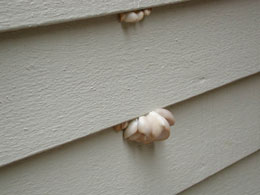 These mushrooms appeared at the side of a house between the time a buyer’s offer was accepted and the day the home inspection occurred. (Photo: Jeffrey May)
These mushrooms appeared at the side of a house between the time a buyer’s offer was accepted and the day the home inspection occurred. (Photo: Jeffrey May) 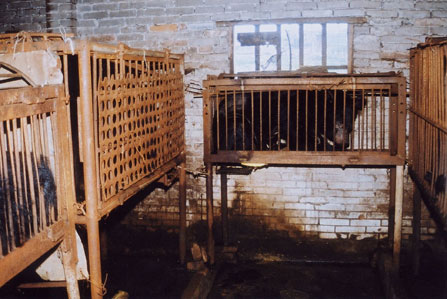 Moon bears are often kept in tiny cages on bear farms. (Photo courtesy of Animals Asia Foundation)
Moon bears are often kept in tiny cages on bear farms. (Photo courtesy of Animals Asia Foundation) 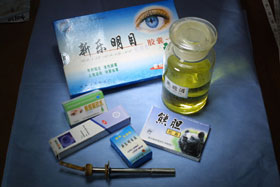 A catheter is used to extract bile from a bear’s gall bladder. Marketed bile products include eye medicines, hemorrhoid cream and bear bile wine. (Photo courtesy of Animals Asia Foundation)
A catheter is used to extract bile from a bear’s gall bladder. Marketed bile products include eye medicines, hemorrhoid cream and bear bile wine. (Photo courtesy of Animals Asia Foundation) 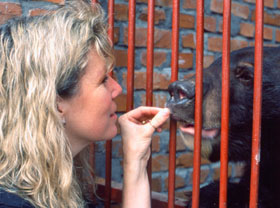 Jill Robinson with Andrew, a rescued Moon Bear. (Photo courtesy of Animals Asia Foundation)
Jill Robinson with Andrew, a rescued Moon Bear. (Photo courtesy of Animals Asia Foundation) 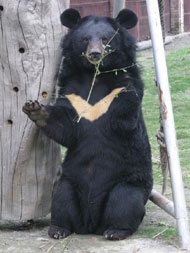 A rescued Moon Bear (Photo courtesy of Animals Asia Foundation)
A rescued Moon Bear (Photo courtesy of Animals Asia Foundation) 





